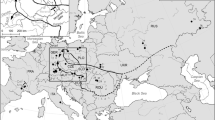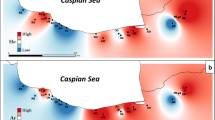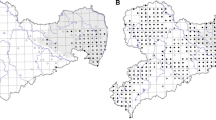Abstract
A comprehensive study of a typical steppe perennial Iris pumila L. were carried out in the central zone of the European part of this species’ range, namely in Ukraine. Intraspecific differentiation, population size and isolation degree and its consequences, the threat of human impact were analyzed, as well as ecological amplitude and genetic variation in ISSR markers and selected chloroplast regions were determined. The species was found to have a low intraspecific differentiation that indicates the uniformity of the gene pool in the studied part of the range. Moreover, the results of isolation assessment, population and ecological study of I. pumila confirm the potential risk of extinction. A considerable part of the species populations exist as separated patches of rare ecosystems, isolated from the nearest neighbours due to intense plowing of the steppe zone. The generative reproduction is rare. In contrast, ISSR analysis revealed comparably high genetic diversity in all the sampled populations. Furthermore, specific plastid haplotypes were demonstrated in some of them. The inconsistency between the results of population ecological study and the data of molecular genetic analysis indicates that the loss of genetic diversity in the species caused by habitat fragmentation and isolation under increasing anthropogenic pressure is likely to be slower than it would appear judging from the assessment of population parameters, which clearly show negative trends. This result also emphasizes the necessity for integrated approach to assessment of the extinction risk for particular species and careful analysis of all determinants of extinction.
Similar content being viewed by others
Abbreviations
- AMOVA:
-
analysis of molecular variance
- CTAB:
-
cetyltrimethylammonium bromide
- DMSO:
-
dimethyl sulfoxide
- ISSR:
-
Inter-Simple Sequence Repeat
- obl.:
-
oblast
- r-n:
-
raion
- vil.:
-
village
References
Aguilar R., Quesada M., Ashworth L., Herreriasdiego Y. & Lobo J. 2008. Genetic consequences of habitat fragmentation in plant populations: susceptible signals in plant traits and methodological approaches. Mol. Ecol. 17: 5177–5188.
Arafeh R.M.H., Sapir Y., Shmida A., Iraki N., Fragman O. & Comes H.P. 2002. Patterns of genetic and phenotypic variation in Iris haynei and I. atrofusca (Iris sect. Oncocyclus = the royal irises) along an ecogeographical gradient in Israel and the West Bank. Mol. Ecol. 11: 39–53.
Artyukova E.V., Kozyrenko M.M., Ilyushko M.V., Zhuravlev Yu.N. & Reunova G.D. 2001. Genetic Variability of Iris setosa. Mol. Biol. (Mosk). 35: 134–138.
Bairak O.M. & Stetsiuk N.O. 2005. Atlas ridkisnkh ta znykayuchkh rosln Poltavshchini. Verstka, Poltava, 248 pp.
Bairak O.M., Shevel I.M., Hrytsai I.A., Kryvoruchko T.V. & Nechytailo V.I. 2006. Botanichnii zakaznik Drabinivka. Verstka, Poltava, 81 pp.
Bezusko L.G., Mosiakin S.L., Bezusko A.G. 2011. Zakonomirnosti ta tendentsiyi rozvytku roslynnoho pokryvu Ukrayiny u pizn’omu pleistotseni ta holotseni. Alterpress, Kyiv, 488 pp.
Biodiversity Support Program. 1999. Priority setting in conservation: A new approach for Crimea. Washington, D.C., 257 pp.
Bokov V.A. 1999. Perspektivi sozdaniya Edinoi prirodookhrannoi seti Kryma. Crimean educational pedagogical publishing house, Simferopol, 192 pp.
Brown A., Young A., Burdon J., Christidis L., Clarke G., Coates D. & Sherwin W. 1997. Genetic indicators for state of the environment reporting, Australia: State of the Environment Technical Paper Series (Environmental Indicators), Department of the Environment, Sport and Territories, Canberra, 30 pp.
Chopyk V.I., Bortniak M.M., Voitiuk Yu.O. et al. 1998. Konspekt flory Seredn’oho Prydniprov”ya. Fitosotsiotsentr, Kyiv, 139 pp.
Dalmady J. 1972. Iris species on Slovenski Kras area. Nature Prot. 3: 64–65.
Osoblivosti ontohenezu Iris pumila, pp. 246–247. In: Materialy naukovoyi konferentsiyi “Bilolohiya: vid molekuly do biosfery”, November 17–21, 2009, Kharkiv.
Didenko I.P., Shvets T.A. & Tomashevska N.P. 2010. Ekolohotsenotychni osoblivosti Iris pumila L. v Kirovohrads’ki oblasti, pp. 206. In: Aktual’ni problemy botaniky ta ekolohiyi. Materialy mizhnarodnoyi konferentsiyi molodykh uchenykh, September 21–25, 2010, Yalta, Simpheropol.
Didukh Ya.P. 2011. The ecological scales for the species of Ukrainian flora and their use in synphytoindication. Phytosociocentr, Kyiv, 176 pp.
Didukh Ya.P. 2009. Zelena kniha Ukrainy. Altpress, Kyiv, 448 pp.
Didukh Ya.P. 2009. Chervona kniha Ukrayiny. Roslynni svit. Globalconsulting, Kyiv, 900 pp.
Dobrochaeva D.N., Kotov M.I., Prokudin Yu.N., et al. 1999. Opredelitel’ vysshikh rastenii Ukrainy. Fitosoctsiotsentr, Kiev, 548 pp.
Doyle J.J. & Doyle J.L. 1987. A rapid DNA isolation procedure for small quantities of fresh leaf tissue. Phytochem. Bull. 19: 11–15.
Ewers R.M. & Didham R.K. 2006. Confounding factors in the detection of species responses to habitat fragmentation. Biol. Rev. 81: 117–142.
Fisher M., Musi R., Prater D., Peintinger M., Van Kleunen M., Shmidt B. 2000. RAPD variation among and within small and large populations of the rare clonal plant Ranunculus reptans (Ranunculaceae). Am. J. Bot. 87: 1128–1137.
Fedyaeva V.V., Shmaraeva A.N. & Shyshlova Zh.N. 2011. Monitoring populyatsii Iris pumila L. v Rostovskoi oblasti. Nauchnye vedomosti Belgorodskogo gosudarstvennogo universiteta. Estestvennie nauki. 15: 326–331.
Gouy M., Guindon S. & Gascuel O. 2010. SeaView version 4: a multiplatform graphical user interface for sequence alignment and phylogenetic tree building. Mol. Biol. Evol. 27: 221–224.
Kostrakiewicz K. & Wróblewska A. 2008. Low genetic variations in subpopulations of an endangered clonal plant Iris sibirica in Southern Poland. Ann. Bot. Fenn. 45: 186–194.
Kozyrenko M.M., Artyukova E.V. & Zhuravlev Yu.N. 2009. Independent species status of Iris vorobievii N.S. Pavlova, Iris mandshurica Maxim., and Iris humilis Georgi (Iridaceae): Evidence from the nuclear and chloroplast genomes. Russ. J. Genet. 45: 1394–1402.
Kozyrenko M.M., Artyukova E.V., Boltenkov E.V. & Lauve L.S. 2004. Somaklonal’naya izmenchivost’ Iris pseudacorus L. po dannym RAPD- i tsitogeneticheskogo analiza. Russ. J. Biotechnol. 20 (2): 13–23.
Kucherevskyi V.V. 2001. Atlas ridkisnykh ta znykayuchykh roslin Dnipropetrovshchyny, Phytosociocentr, Kyiv, 360 pp.
Kucherevskyi V.V. 2004. Konspekt flory Pravoberezhnoho stepovoho Prydniprov”ya, Prospect, Dnipropetrovsk, 292 pp.
Leimu R., Mutikainen P., Koricheva J. & Fischer M. 2006. How general are positive relationships between plant population size, fitness and genetic variation? J. Ecol. 94: 942–952.
Hoskovec L. 2007. Zvláště chráněné druhy rostlin České republiky. https://doi.org/botany.cz/cs/chranene-rostliny/cs/chranene-rostliny/ (accessed 11.11. 2015).
Eliáš jun. P. 2015. Červený zoznam výtrusných a kvitnúcich rastlín Slovenska. https://doi.org/botany.cz/cs/ohrozene-rastliny-slovenska//cs/ohrozene-rastliny-slovenska (accessed 11.11.2015).
Lienert J. 2004. Habitat fragmentation effects on fitness of plant populations — a review. J. Nat. Conserv. 12: 53–72.
Makarevitch I., Golovnina K., Scherbik S. & Blinov A. 2003. Phylogenetic relationships of the Siberian Iris species inferred from noncoding chloroplast DNA sequences. Int. J. Plant Sci. 164: 229–237.
Mosyakin S.L. & Fedoronchuk M.M. 1999. Vascular plants of Ukraine: A nomenclatural checklist. M.G. Kholodny Institute of Botany, Kyiv, 346 pp.
Motyka J., 1946. Step środkowo-europejski. Acta Soc. Bot. Pol. 17: 46.
Ostapko V.M. & Kolomyichuk V.P. 2012. Krasnaya kniga Priazovskogo regiona. Sosudistie rasteniya. Altapress, Kyiv, 267 pp.
Ostapko V.M. 2001. Raritetnyi florofond Yugo-Vostoka Ukrainy (khorolohiya). Lybed, Donetsk, 121 pp.
Parnikoza I. 2008. Zberezhennya ukrayins’koho stepu: shcho mozhna zrobiti vzhe s’ohodni? pp. 53–62. In: Zagorodniuk I.V. (ed.), Rare theriofauna and its conservation, 9, Luhansk.
Parnikoza I. 2011. Deyaki refuhiumy stepovoyi bioty ta mistsezrostannya ridkisnikh roslin v okolytsyakh mist Kryvy Rih ta Dnipropetrovs’k, pp. 31–40. In: Naukovi pratsi Luhans’koho prirodnoho zapovidnika. Roslinnii ta tvarinnii svit ta ioho okhorona. The flora and fauna, and conservation], Issue 2, Luhansk.
Parnikoza I.Yu., Shevchenko N.M., Bogomaz M.V. & Shevchenko M.S. 2007. The influence of grass burning on the dynamics of Pulsatilla nigricans Stork population of the regional landscape park “Lysa Gora” (Kyiv), pp. 4–5. In: Szhmalej S.A., Rusina L.Yu., Akimov I.A. (eds), Falz-Fein Readings. PP Vyshemyrskyi, Kherson.
Parnikoza I.Yu., Shevchenko M.S., Inozemtseva D.M., Vasyliuk O.V. & Shevchenko O.S. 2008. Raritetna flora (Okhorona, vivchennya, reintroduktsiya). Kyiv ecological and cultural centre, Kyiv, 132 pp.
Peakall R. & Smouse P.E. 2006. GENALEX 6: genetic analysis in Excel. Population genetic software for teaching and research. Mol. Ecol. 6: 288–295.
Poradniki ochrony siedlisk i gatunków. Natura 2000 — podrecznik metodyczny, Murawy kserotermiczne. T. 3. 2004. Warszawa, 244 pp. https://doi.org/natura2000.gdos.gov.pl/uploads/download/219uploads/download/219 (accessed 31.07.2016)
Purger D., Csiky J., Topić J. 2008. Dwarf iris, Iris pumila L. (Iridaceae), a new species of the Croatian flora. Acta Bot. Croat. 67: 97–102.
Safriel N.U., Volis S. & Kark S. 1994. Core and peripheral populations and global climate change. Isr. J. Plant Sci. 42: 331–345.
Schluter P.M. & Harris S.A. 2006. Analysis of multilocus fingerprinting data sets containing missing data. Mol. Ecol. Notes. 6: 569–572.
Shaw J., Lickey E.B., Schilling E.E. & Small R.L. 2007. Comparison of whole chloroplast genome sequences to choose non-coding regions for phylogenetic studies in angiosperms: The tortoise and the hare III. Am. J. Bot. 94: 275–288.
Shelegeda V.I. & Shelegeda O.R. 2008. Ridkisni ta znikayuchi roslini Zaporiz’koyi oblasti. Tandem-art-studia, Zaporizhzhia, 96 pp.
Shvets T.A. 2004. Osoblivosti ontohenezu predstavnikiv riznikh sektsii rodu Iris L. v umovakh kul’turi. Visnik Lvivskoho universitetu. Seriia biolohichna. 36: 203–206.
Sikura I.I. & Shisha E.N. 2008. Genus Iris L. (Iridaceae). Znania Ukrainy, Kiev, 195 pp.
Sluginova I.S. 2008. Semennaya produktyvnost’ nekotorikh vidov rasteniĭ melovikh obnazheniĭ basseĭna Polnoĭ. Izvestiia vuzov. Severo-Kavkazskiĭ region. Estestv. Nauki. 146: 75–79.
Taberlet P., Gielly L., Pautou G. & Bouvet J. 1991. Universal primers for amplification of three non-coding regions of chloroplast DNA. Plant Mol. Biol. 17: 1105–1109.
Tarasjev A., Klicaric N.B., Stojkovic B. & Avramov S. 2009. Phenotypic plasticity and between population differentiation in Iris pumila transplants between native open and anthropogenic shade habitats. Russ. J. Genet. 45: 1078–1086.
Tarasov V.V. 2005. Flora Dnipropetrovs’koyi ta Zaporiz’koyi oblastei. Sudinni roslini. Bioloho-ekolohichna kharakteristika vidiv: Monohrafiya. Publ. House of DNU, Dnipropetrovsk, 276 pp.
Templeton A.R., Crandall K.A. & Sing C.F. 1992. A cladistic analysis of phenotypic associations with haplotypes inferred from restriction endonuclease mapping and DNA sequence data. III. Cladogram estimation. Genetics. 132: 619–633.
Tkachenko V.S., Didukh Ya.P., Henov A.P. et al. 1998. Ukrayins’kiĭ pryrodniĭ stepoviĭ zapovidnik. Roslynniĭ svit. Fitosotsiotsentr, Kyiv, 232 pp.
Travlieiev A.P. 2010. Chervona Kniha Dinpropetrovs’koyi oblasti (Roslynniĭ svit). VKK “Blans-Klub”, Dnipropetrovsk, 500 p.
Vedenkov E.P. 1989. Flora zapovidnika “Askaniya Nova”. Moscow, 50 pp.
Wang K., Kang J., Zhou H., Sun Y., Yang Q., Dong J. & Meng L. 2009. Genetic diversity of Iris lactea var. chinensis germplasm detected by inter-simple sequence repeat (ISSR). Afr. J. Biotechnol. 8: 4856–4863.
World checklist of selected plant families. https://doi.org/apps.kew.org/wcsp/qsearch.dowcsp/qsearch.do (accessed 11.11.2015).
Wróblewska A., Brzosko E., Czarnecka B. Nowosielski J. 2003. High levels of genetic diversity in populations of Iris aphylla L. (Iridaceae), an endangered species in Poland. Bot. J. Linn. Soc. 142: 65–72.
Wróblewska A. & Brzosko E. 2006. The genetic structure of the steppe plant Iris aphylla L. at the northern limit of its geographical range. Bot. J. Linn. Soc. 152: 245–255.
Yena A.V. 2012. Prirodnaya flora Krymskogo poluostrova. N. Oreanda, Simpheropol, 232 pp.
Xie Z., Lu Y., Ge Song, Hong D and Li F. 2001. Clonality in wild rice (Oryza rufipogon, Poaceae) and its implications for conservation management. Am. J. Bot. 88: 1058–1064.
Author information
Authors and Affiliations
Corresponding author
Rights and permissions
About this article
Cite this article
Parnikoza, I.Y., Andreev, I.O., Bublyk, O.M. et al. The current state of steppe perennial plants populations: A case study on Iris pumila. Biologia 72, 24–35 (2017). https://doi.org/10.1515/biolog-2017-0002
Received:
Accepted:
Published:
Issue Date:
DOI: https://doi.org/10.1515/biolog-2017-0002




